Quebec City
Québec | ||
|---|---|---|
City | ||
| Ville de Québec (French) | ||
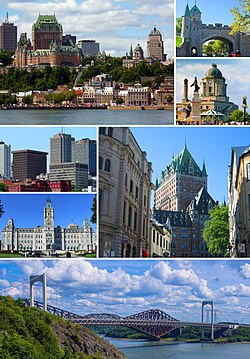 From top, left to right: Quebec City from the St. Lawrence River, the Ramparts of Quebec City, waterfront in Old Quebec, skyscrapers in Vieux-Québec, Parliament Building, Château Frontenac, Pierre Laporte Bridge | ||
|
Agglomeration of Quebec City | ||
| Historic countries | Kingdom of France Kingdom of Great Britain | |
| First settled | 11 October 1535, by Jacques Cartier | |
| Founded | 3 July 1608, by Samuel de Champlain | |
| Constituted | 1 January 2002 | |
| Incorporated | 1832[4] | |
| Boroughs | ||
| Government MPs | List of MPs | |
| • MNAs | List | |
| Area GDP (Québec CMA) | CA$42.8 billion (2016)[11] | |
| GDP per capita (Québec CMA) | CA$53,477 (2016) | |
| Website | ville | |
| Official name | Historic District of Old Quebec | |
| Type | Cultural | |
| Criteria | iv, vi | |
| Designated | 1985 (9th session) | |
| Reference no. | 300 | |
| Region | Europe and North America | |
Quebec City (/kwɪˈbɛk/ ⓘ or /kəˈbɛk/;[12] French: Ville de Québec), officially Québec (French pronunciation: [kebɛk]),[13] is the capital city of the Canadian province of Quebec. As of July 2021, the city had a population of 549,459,[14] and the metropolitan area had a population of 839,311.[15] It is the eleventh-largest city and the seventh-largest metropolitan area in Canada. It is also the second-largest city in the province, after Montreal. It has a humid continental climate with warm summers coupled with cold and snowy winters.
Explorer
Name and usage
Common English-language usage distinguishes the city from the province by referring to the former as Quebec City.[18]
According to the Government of Canada, the Government of Quebec, and the Geographical Names Board of Canada, the names of Canadian cities and towns have only one official form. Thus, Québec is officially spelled with an accented é in both Canadian English and French.[19][20][21] However, province names can have different forms in English and French. As a result, in English, the federal government style distinguishes the city and province by spelling the city with an acute accent (Québec) and the province without one (Quebec). The government of Quebec spells both names "Québec", including when writing in English.[22]
In French, the two are distinguished in that province names including Quebec generally take
The
The city's landmarks include the Château Frontenac hotel that dominates the skyline and the Citadelle of Quebec, an intact fortress that forms the centrepiece of the ramparts surrounding the old city and includes a secondary royal residence. The National Assembly of Quebec (provincial legislature), the Musée national des beaux-arts du Québec (National Museum of Fine Arts of Quebec), and the Musée de la civilisation (Museum of Civilization) are found within or near Vieux-Québec.
History
French Regime (1500s–1763)
Quebec City is one of the oldest European settlements in North America and the only fortified city north of Mexico whose walls still exist.[24] While many of the major cities in Latin America date from the 16th century, among cities in Canada and the U.S., few were created earlier than Quebec City (St. John's, Harbour Grace, Port Royal, St. Augustine, Santa Fe, Jamestown, and Tadoussac).

It is home to the earliest known French settlement in North America, Fort Charlesbourg-Royal, established in 1541 by explorer Jacques Cartier with some 400 persons but abandoned less than a year later due to the harsh winter and resistance of indigenous inhabitants to colonial incursion on their land.[25] The fort was at the mouth of the Rivière du Cap Rouge, in the suburban former town of Cap-Rouge (which merged into Quebec City in 2002).
Quebec was founded by Samuel de Champlain, a French explorer and diplomat, on 3 July 1608,[26][27] and at the site of a long abandoned St. Lawrence Iroquoian settlement called Stadacona. Champlain, who came to be called "The Father of New France", served as its administrator for the rest of his life.
The name "Canada" was given to the colony that developed around the settlement at Quebec. Although the Acadian settlement at Port-Royal was established three years earlier, Quebec came to be known as the cradle of North America's Francophone population. The location seemed favourable to the establishment of a permanent colony.
The population of the settlement remained small for decades. In 1629 it was
In 1665, there were 550 people in 70 houses living in the city. One-quarter of the people were members of religious orders: secular priests, Jesuits, Ursulines nuns and the order running the local hospital, Hôtel-Dieu.[29]
Quebec was the headquarters of many raids against New England during the French and Indian Wars. In 1690 the city was attacked by the English, but was successfully defended. In the last of the conflicts, the French and Indian War (Seven Years' War), Quebec was captured by the British in 1759, and held until the end of the war in 1763. In that time many battles and sieges took place: the Battle of Beauport, a French victory (31 July 1759); the Battle of the Plains of Abraham, in which British troops under General James Wolfe defeated the French General Louis-Joseph de Montcalm on 13 September 1759, and shortly thereafter took the city after a short siege. A French counterattack saw a French victory at the Battle of Sainte-Foy (28 April 1760) but the subsequent second Siege of Quebec the following month however saw a final British victory.
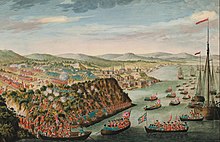
France ceded New France, including the city, to Britain in 1763,[30] when the French and Indian War officially ended.
At the end of French rule, Quebec was a town of 8,000 inhabitants, surrounded by forests, villages, fields and pastures. The town was distinguished by its monumental architecture, fortifications, and affluent homes of masonry and shacks in the suburbs of Saint-Jean and Saint-Roch. Despite its urbanity and its status as capital, Quebec remained a small city with close ties to its rural surroundings. Nearby inhabitants traded their farm surpluses and firewood for imported goods from France at the two city markets.
British and Canadian rule (1763–present)
This section needs additional citations for verification. (April 2016) |
During the
The city itself was not attacked during the War of 1812, when the United States again attempted to annex Canadian lands. Amid fears of another American attack on Quebec City, construction of the Citadelle of Quebec began in 1820. The Americans did not attack Canada after the War of 1812, but the Citadelle continued to house a large British garrison until 1871. It is still in use by the military and is also a tourist attraction.
Until the late 18th century Québec was the most populous city in present-day Canada. As of the census of 1790, Montreal surpassed it with 18,000 inhabitants, but Quebec (pop. 14,000) remained the administrative capital of the former New France.
Before the Royal Military College of Canada was established in 1876, the only French-speaking officer training school was the Quebec City School of Military Instruction, founded in 1864.[34] The school was retained at Confederation, in 1867. In 1868, The School of Artillery was formed in Montreal.[35]
The Quebec Conference on Canadian Confederation was held in the city in 1864. In 1867, Queen Victoria chose Ottawa as the definite capital of the Dominion of Canada, while Quebec City was confirmed as the capital of the newly created province of Quebec.
During World War II, two conferences were held in Quebec City. The
Until 2002, Quebec was a mostly urbanized city and its territory coterminous with today's borough of
Geography

Quebec City was built on the north bank of the
The
The area was affected by the 1925 Charlevoix–Kamouraska earthquake.
The administrative region in which it is situated is officially referred to as Capitale-Nationale,[38][39] and the term "national capital" is used to refer to Quebec City itself at the provincial level.[40]
Climate
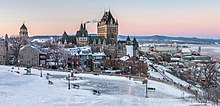
Quebec City is classified as a humid continental climate (Köppen climate classification Dfb).[41]
Quebec City experiences four distinct seasons. Summers are warm and occasionally hot, with periods of hotter temperatures which compounded with the high humidity, create a high heat index that belies the average high of 22–25 °C (72–77 °F) and lows of 11–13 °C (52–55 °F). Winters are cold, windy and snowy with average high temperatures −5 to −8 °C (23 to 18 °F) and lows −13 to −18 °C (9 to 0 °F). Spring and fall, although short, bring chilly to warm temperatures. Late heat waves as well as "Indian summers" are a common occurrence.[citation needed]
On average, Quebec City receives 1,190 millimetres (46.85 in) of precipitation, of which 899 millimetres (35.39 in) is rain and 303 millimetres (11.93 in) is the melt from 316 centimetres (124.4 in) of snowfall per annum.[note 2] The city experiences around 1,916 hours of bright sunshine annually or 41.5% of possible sunshine, with summer being the sunniest, but also slightly the wettest season. During winter, snow generally stays on the ground from the end of November till mid-April.
The highest temperature ever recorded in Quebec City was 36.1 °C (97.0 °F) on 17 July 1953.[42] The coldest temperature ever recorded was −36.7 °C (−34.1 °F) on 10 January 1890 and 14 January 2015.[43][44]
| Climate data for Sainte-Foy, Quebec City (Québec City Jean Lesage International Airport) WMO ID: 71708; coordinates 46°48′N 71°23′W / 46.800°N 71.383°W; elevation: 74.4 m (244 ft); 1981–2010 normals, extremes 1875–present[note 3] | |||||||||||||
|---|---|---|---|---|---|---|---|---|---|---|---|---|---|
| Month | Jan | Feb | Mar | Apr | May | Jun | Jul | Aug | Sep | Oct | Nov | Dec | Year |
| Record high humidex | 10.6 | 11.7 | 17.8 | 32.9 | 40.3 | 44.1 | 49.2 | 49.3 | 40.1 | 30.9 | 24.9 | 14.6 | 49.3 |
| Record high °C (°F) | 11.1 (52.0) |
11.7 (53.1) |
18.3 (64.9) |
29.9 (85.8) |
33.0 (91.4) |
34.4 (93.9) |
36.1 (97.0) |
35.6 (96.1) |
33.9 (93.0) |
28.3 (82.9) |
22.9 (73.2) |
15.0 (59.0) |
36.1 (97.0) |
| Mean daily maximum °C (°F) | −7.9 (17.8) |
−5.6 (21.9) |
0.2 (32.4) |
8.3 (46.9) |
17.0 (62.6) |
22.3 (72.1) |
25.0 (77.0) |
23.6 (74.5) |
17.9 (64.2) |
11.1 (52.0) |
2.9 (37.2) |
−4.2 (24.4) |
9.2 (48.6) |
| Daily mean °C (°F) | −12.8 (9.0) |
−10.6 (12.9) |
−4.6 (23.7) |
3.7 (38.7) |
11.2 (52.2) |
16.4 (61.5) |
19.3 (66.7) |
18.1 (64.6) |
12.7 (54.9) |
6.6 (43.9) |
−0.7 (30.7) |
−8.6 (16.5) |
4.2 (39.6) |
| Mean daily minimum °C (°F) | −17.7 (0.1) |
−15.6 (3.9) |
−9.4 (15.1) |
−1.0 (30.2) |
5.4 (41.7) |
10.5 (50.9) |
13.5 (56.3) |
12.5 (54.5) |
7.5 (45.5) |
2.0 (35.6) |
−4.2 (24.4) |
−12.8 (9.0) |
−0.8 (30.6) |
| Record low °C (°F) | −36.7 (−34.1) |
−36.1 (−33.0) |
−30.0 (−22.0) |
−18.9 (−2.0) |
−7.8 (18.0) |
−0.6 (30.9) |
3.9 (39.0) |
2.2 (36.0) |
−4.8 (23.4) |
−10.0 (14.0) |
−26.1 (−15.0) |
−35.6 (−32.1) |
−36.7 (−34.1) |
| Record low wind chill | −51.1 | −52.4 | −41.0 | −29.0 | −13.6 | 0.0 | 0.0 | 0.0 | −7.8 | −17.3 | −30.8 | −48.4 | −52.4 |
| Average precipitation mm (inches) | 86.6 (3.41) |
74.5 (2.93) |
76.1 (3.00) |
83.5 (3.29) |
115.9 (4.56) |
111.4 (4.39) |
121.4 (4.78) |
104.2 (4.10) |
115.5 (4.55) |
98.3 (3.87) |
102.5 (4.04) |
99.9 (3.93) |
1,189.7 (46.84) |
| Average rainfall mm (inches) | 22.7 (0.89) |
15.2 (0.60) |
30.2 (1.19) |
67.5 (2.66) |
115.9 (4.56) |
111.4 (4.39) |
121.4 (4.78) |
104.2 (4.10) |
115.5 (4.55) |
94.6 (3.72) |
69.1 (2.72) |
31.7 (1.25) |
899.3 (35.41) |
| Average snowfall cm (inches) | 71.9 (28.3) |
63.6 (25.0) |
46.4 (18.3) |
13.2 (5.2) |
0.0 (0.0) |
0.0 (0.0) |
0.0 (0.0) |
0.0 (0.0) |
0.0 (0.0) |
3.2 (1.3) |
32.7 (12.9) |
72.4 (28.5) |
303.4 (119.4) |
| Average precipitation days (≥ 0.2 mm) | 17.1 | 14.3 | 13.4 | 12.1 | 15.4 | 13.4 | 13.5 | 13.4 | 13.4 | 14.4 | 16.0 | 18.5 | 174.9 |
| Average rainy days (≥ 0.2 mm) | 3.0 | 2.4 | 4.7 | 10.4 | 15.3 | 13.4 | 13.5 | 13.4 | 13.4 | 14.1 | 10.1 | 4.5 | 118.2 |
| Average snowy days (≥ 0.2 cm) | 16.3 | 13.2 | 10.5 | 4.3 | 0.13 | 0.0 | 0.0 | 0.0 | 0.0 | 1.0 | 8.1 | 16.6 | 70.1 |
| Average relative humidity (%) (at 3pm)
|
67.8 | 64.6 | 60.7 | 55.9 | 51.6 | 56.0 | 59.1 | 59.1 | 61.8 | 63.1 | 70.4 | 73.2 | 61.9 |
| Mean monthly sunshine hours | 98.9 | 121.2 | 152.0 | 170.6 | 211.1 | 234.7 | 252.3 | 232.0 | 163.0 | 122.0 | 76.6 | 81.9 | 1,916.3 |
| Percent possible sunshine | 35.5 | 41.8 | 41.3 | 41.9 | 45.3 | 49.6 | 52.7 | 52.7 | 43.1 | 36.0 | 27.1 | 30.7 | 41.5 |
| Average ultraviolet index | 1 | 2 | 3 | 4 | 6 | 7 | 7 | 6 | 5 | 3 | 1 | 1 | 4 |
| Source: Environment and Climate Change Canada,[45][46] extremes 1875–1959[47] and Weather Atlas[48] | |||||||||||||
Boroughs and neighbourhoods
This section needs additional citations for verification. (April 2016) |
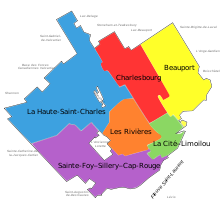
On 1 January 2002, the 12 former towns of
Quebec City's six
Compared to many other cities in North America, there is less variation between average household incomes between the neighbourhoods. However, some disparities exist. The southwest former cities of Sillery, Cap-Rouge and Sainte-Foy are considered to be the wealthiest, along with some parts of Montcalm and Old Quebec.[citation needed]
The city's traditional working-class areas are found in the lower town below Old Quebec (Saint-Sauveur and Saint-Roch) and directly across the Saint-Charles River to the north (Vanier and Limoilou). However, parts of Limoilou, Saint-Sauveur and particularly Saint-Roch have seen gentrification in the last 20 years, attracting young professionals and the construction of new offices and condos.[51]
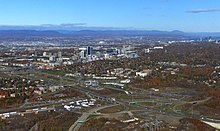
Northern sections (Loretteville, Val-Bélair) and eastern sections (Beauport, Charlesbourg) are mostly a mix of middle-class residential suburbs with industrial pockets.
| Boroughs | Neighbourhoods |
| 1 La Cité-Limoilou | La Cité: 1-1 Vieux-Québec–Cap-Blanc–colline Parlementaire · 1-2 Saint-Roch · 1-3 Saint-Jean-Baptiste · 1-4 Montcalm · 1-5 Saint-Sauveur · 1-6 Saint-Sacrement · Limoilou: 6-1 Vieux-Limoilou · 6-2 Lairet · 6-3 Maizerets
|
| 2 Les Rivières
|
2-1 Neufchâtel-Est–Lebourgneuf · 2-2 Duberger-Les Saules · 2-3 Vanier |
| 3 Sainte-Foy–Sillery–Cap-Rouge | 3-1 Sillery · 3-2 Cité universitaire · 3-3 Saint-Louis · 3-4 Plateau · 3-5 Pointe-de-Ste-Foy 8-2 · L'Aéroport · 8-3 Cap-Rouge |
| 4 Charlesbourg | 4-1 Notre-Dame-des-Laurentides · 4-2 Quartier 4-2 · 4-3 Quartier 4-3 · 4-4 Jésuites, Quebec City · 4-5 Quartier 4-5 · 4-6 Quartier 4-6 |
| 5 Beauport | 5-1 Quartier 5-1 · 5-2 Quartier 5-2 · 5-3 Chutes-Montmorency · 5-4 Quartier 5-4 · 5-5 Vieux-Moulin |
| 7 La Haute-Saint-Charles
|
7-1 Lac-Saint-Charles · 7-2 Saint-Émile · 7-3 Loretteville · 7-4 Des Châtels · 8-1 Val-Bélair |
Demographics
This section needs additional citations for verification. (April 2016) |
| 78,118 | +13.3% | |
| 1921c | 95,193 | +21.9% |
|---|---|---|
| 1931 | 130,594 | +37.2% |
| 1941 | 150,757 | +15.4% |
| 1951 | 164,016 | +8.8% |
| 1956 | 170,703 | +4.1% |
| 1961 | 171,979 | +0.7% |
| 1966 | 166,984 | −2.9% |
| 1971d | 186,088 | +11.4% |
| 1976e | 177,082 | −4.8% |
| 1981 | 165,968 | −6.3% |
| 1986 | 164,580 | −0.8% |
| 1991 | 167,517 | +1.8% |
| 1996 | 167,264 | −0.2% |
| 2001 | 169,076 | +1.1% |
| 2006f | 491,142 | +190.5% |
| 2011 | 516,622 | +5.2% |
| 2016 | 531,902 | +3.0% |
| 2021 | 549,459 | +3.3% |
a Quebec City annexed the Village of Saint-Sauveur-de-Québec bQuebec City annexed the Town of Limoilou and the Village of Saint-Malo cQuebec City annexed the Town of Montcalm dQuebec City annexed the Town of Duberger and the Town of Les Saules eQuebec City annexed the Town of Neufchâtel and the Municipality of Charlesbourg-Ouest fQuebec City annexed the cities of Beauport, Cap-Rouge, Charlesbourg, Lac-Saint-Charles, Loretteville, Saint-Émile, Sainte-Foy, Sillery, Val-Bélair and Vanier | ||
| 102,214 | +15.3% | |
| 1921 | 122,698 | +20.0% |
|---|---|---|
| 1931 | 168,249 | +37.1% |
| 1941 | 199,588 | +18.6% |
| 1951 | 245,742 | +23.1% |
| 1956 | 279,521 | +13.7% |
| 1961 | 321,917 | +15.2% |
| 1966 | 372,373 | +15.7% |
| 1971 | 408,440 | +9.7% |
| 1976 | 429,757 | +5.2% |
| 1981 | 434,980 | +1.2% |
| 1986 | 440,598 | +1.3% |
| 1991 | 461,894 | +4.8% |
| 1996 | 473,569 | +2.5% |
| 2001 | 476,330 | +0.6% |
| 2006 | 491,142 | +3.1% |
| 2011 | 516,622 | +5.2% |
| 2016 | 531,902 | +3.0% |
| 2021 | 549,459 | +3.3% |
In the 2021 Census of Population conducted by Statistics Canada, Québec had a population of 549,459 living in 265,711 of its 283,219 total private dwellings, a change of 3.3% from its 2016 population of 531,902. With a land area of 452.3 km2 (174.6 sq mi), it had a population density of 1,214.8/km2 (3,146.3/sq mi) in 2021.[54]
According to Statistics Canada, there were 839,311 people residing in the Quebec City census metropolitan area.[55]
In 2016, 20.6% of the resident population in Quebec City was of retirement age (65 and over for males and females) compared with 16.9% in Canada. The median age is 43.3 years of age compared to 41.2 years of age for Canada as a whole. In the five years between 2011 and 2016, the population of Quebec City grew by 3%.[56]
Ethnicity
In 2021,[57] 9.4% of Quebec City residents reported visible minority status, a relatively low figure for a large Canadian city; the national average was 26.5%.[58] The largest visible minority group were Black Canadians, who formed 4.1% of the population. Quebec City also had a lower percentage of Indigenous Canadians (1.8%) than the national average of 5.0%.[59]
| Panethnic group |
2021[59] | 2016[60] | 2011[61] | 2006[62] | 2001[63] | |||||||||
|---|---|---|---|---|---|---|---|---|---|---|---|---|---|---|
| Pop. | % | Pop. | % | Pop. | % | Pop. | % | Pop. | % | |||||
| European[a] | 473,770 | 88.8% | 475,720 | 92.15% | 477,715 | 95.05% | 465,115 | 96.39% | 160,940 | 96.8% | ||||
Black
|
21,955 | 4.11% | 12,430 | 2.41% | 5,760 | 1.15% | 4,550 | 0.94% | 1,335 | 0.8% | ||||
| Middle Eastern[b] | 10,510 | 1.97% | 6,850 | 1.33% | 4,045 | 0.8% | 2,980 | 0.62% | 370 | 0.22% | ||||
| Indigenous | 9,395 | 1.76% | 7,290 | 1.41% | 4,635 | 0.92% | 3,140 | 0.65% | 1,055 | 0.63% | ||||
| Latin American | 8,585 | 1.61% | 6,675 | 1.29% | 5,085 | 1.01% | 2,725 | 0.56% | 1,095 | 0.66% | ||||
| Southeast Asian[c] | 3,275 | 0.61% | 2,590 | 0.5% | 1,855 | 0.37% | 1,470 | 0.3% | 820 | 0.49% | ||||
| East Asian[d] | 2,970 | 0.56% | 2,565 | 0.5% | 2,080 | 0.41% | 1,730 | 0.36% | 420 | 0.25% | ||||
| South Asian | 1,610 | 0.3% | 1,390 | 0.27% | 855 | 0.17% | 425 | 0.09% | 120 | 0.07% | ||||
| Other/Multiracial[e] | 1,465 | 0.27% | 730 | 0.14% | 570 | 0.11% | 405 | 0.08% | 110 | 0.07% | ||||
| Total responses | 533,540 | 97.1% | 516,250 | 97.06% | 502,595 | 97.28% | 482,545 | 98.25% | 166,255 | 98.33% | ||||
| Total population | 549,459 | 100% | 531,902 | 100% | 516,622 | 100% | 491,142 | 100% | 169,076 | 100% | ||||
| Note: Totals greater than 100% due to multiple origin responses | ||||||||||||||
Immigration
The 2021 census reported that immigrants (individuals born outside Canada) comprise 45,230 persons or 8.5% of the total population of Quebec City. Of the total immigrant population, the top countries of origin were France (7,360 persons or 16.3%), Colombia (2,865 persons or 6.3%), Morocco (2,715 persons or 6.0%), Ivory Coast (2,500 persons or 5.5%), Cameroon (2,225 persons or 4.9%), Algeria (1,920 persons or 4.2%), Tunisia (1,795 persons or 4.0%), Democratic Republic of the Congo (1,315 persons or 1,315%), Haiti (1,120 persons or 2.5%), and Brazil (1,115 persons or 2.5%).[59]
Language
The great majority of city residents are native French speakers. The English-speaking community peaked in relative terms during the 1860s, when 40% of Quebec City's residents were
In 2021, according to Statistics Canada, 90.6% of Quebec City's population spoke French as their sole mother tongue. More than a third of city residents reported being capable of speaking both French and English.
| Census Year |
Total Responses |
French
|
English
|
French & English
|
Other
| |||||||||||||
|---|---|---|---|---|---|---|---|---|---|---|---|---|---|---|---|---|---|---|
| Count | Trend | Pop. % | Count | Trend | Pop. % | Count | Trend | Pop. % | Count | Trend | Pop. % | |||||||
2021
|
542,435
|
491,515 | 90.6% | 7,685 | 1.4% | 4,530 | 0.8% | 33,255 | 6.1% | |||||||||
2016
|
523,560
|
483,790 | 92.4% | 7,395 | 1.4% | 2,615 | 0.5% | 26,370 | 5.0% | |||||||||
2011
|
516,622
|
478,395 | 92.6% | 7,370 | 1.4% | 2,315 | 0.5% | 19,790 | 3.8% | |||||||||
2006
|
491,142
|
456,225 | 92.9% | 7,030 | 1.4% | 1,460 | 0.3% | 17,825 | 3.6% | |||||||||
2001
|
471,962
|
447,840 | 94.9% | 6,830 | 1.5% | 2,020 | 0.4% | 11,535 | 2.4% | |||||||||
1996
|
467,455
|
446,194 | n/a | 95.5% | 8,309 | n/a | 1.8% | 1,955 | n/a | 0.4% | 9,830 | n/a | 2.1% | |||||
Religion
According to the 2021 census, religious groups in Quebec City included:[59]
- Christianity (349,320 residents, or 65.5%)
- Irreligion (162,900; 30.5%)
- Islam (17,490; 3.3%)
- Buddhism (1,565; 0.3%)
- Hinduism (515; 0.1%)
- Judaism(305; 0.1%)
- Indigenous Spirituality(75; <0.1%)
- Sikhism (20; <0.1%)
- Other (1,355; 0.3%)
Economy
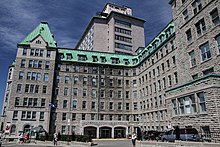
Most jobs in Quebec City are concentrated in public administration, defence, services, commerce, transport and tourism. As the provincial capital, the city benefits from being a regional administrative and services centre: apropos, the provincial government is the largest employer in the city, employing 27,900 people as of 2007.[67] CHUQ (the local hospital network) is the city's largest institutional employer, with more than 10,000 employees in 2007. The unemployment rate in June 2018 was 3.8%, below the national average (6.0%) and the second-lowest of Canada's 34 largest cities, behind Peterborough (2.7%).[68]
Around 10% of jobs are in manufacturing.
Business districts
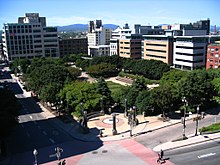
While the traditional central business districts and their large office buildings are found on Parliament Hill (especially for provincial administration) and just below in Saint-Roch (nowadays notable for IT and the video game industry), a newer one has emerged in the Boulevard Laurier area of Sainte-Foy, where a number of accounting and law firms have moved since the 2000s. Other suburban places identified by the city for their potential are the Lebourgneuf area for private offices, as well as Estimauville Street where the Government of Canada already has many civil servants and where several city officials are expected to move in the 2020s.[51]
Arts and culture
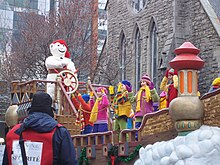
Quebec City is known for its
Québec City has a number of historic sites, art galleries and museums, including Citadelle of Quebec, Musée national des beaux-arts du Québec, Ursulines of Quebec, and Musée de la civilisation.

Other tourist attractions include
Attractions
Given the mass of Cap Diamant and the presence of la Citadelle atop it, overlooking the waters of the St. Lawrence River, Charles Dickens described Quebec City as the "Gibraltar of North America".[72]
Architecture

Much of the city's notable traditional architecture is located in
The upper and lower town are linked by numerous stairs such as the Escalier « casse-cou » ("breakneck stairway") or the



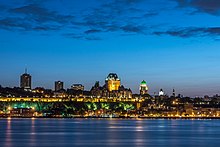
Along with concrete high-rises such as
Near the Château Frontenac is
Parks
One of the most notable is
Other large and centrally located parks are
Quebec is the only large city in Canada along with
- The linear park named Promenade Samuel-De Champlain that stretches 4.6 km (2.9 mi) alongside the Saint Lawrence River, from Pierre Laporte Bridge to Sillery's east-end. Its bicycle and pedestrian paths then continues to Old Quebec and then along the Saint-Charles River.[79] Just like the beach at Beauport Bay, the construction of the Promenade was funded by provincial and federal governments to celebrate the 400th anniversary of Quebec City in 2008.
- Government House (Quebec), slightly west of the Plains of Abraham in Sillery, and known for its natural landscaping as well as traditional gardens, such as those surrounding the historical Villa Bagatelle. The historical significance of the park also lies in the former presence of the viceregal Government House of Quebec (1845–1966).
- The Domaine de Maizerets, where are found an arboretum and an observation tower, not far from the Saint Lawrence River and Beauport Bay.
- Domaine Cataraqui in Sillery.
- The Roger-Van den Hende Botanical Garden of Université Laval.
Sports
Quebec City has hosted a number of recent sporting events, as well as being shortlisted for the

The city currently has one professional team, the baseball team
The city had a professional ice hockey team, the
The
Other teams include the
Quebec City holds the Coop FIS Cross-Country World Cup. This is a ski event that welcomes the best of that sport.[85]
Government
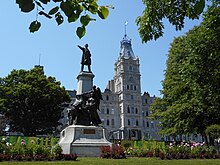
Since the 1960s,
Various lines of thought were offered, including the popularity of the talk radio stations CHOI and FM93 expressing fiscally conservative and non-politically correct opinions.[90] Over the years, this genre has been qualified by its detractors as radio poubelle (fr) ("trash radio") and hosts like Jeff Fillion and André Arthur likened to shock jocks.[91] Also, compared to the rest of the province, people of the area may favour harsher criminal sentences, and lower-class households may share political views more in line with those earning more. The reasons for this remain unclear.[86] Another researcher put forward the historical factors that led to Montreal surpassing Quebec as the metropolis of British North America in the early 19th century. According to this theory, its permanent status of "second city" (albeit the capital) engendered feelings of "repressed jealousy".[92]
The "mystery" was relativized following the 2011 federal election. All five ridings within the city were won by the leftist New Democratic Party, in the so-called "orange wave" that temporarily swept the province. Nonetheless, five of the six seats won by the Conservatives in the province were found in the greater Quebec City area.[93] At the 2018 provincial election, the leftist party Québec solidaire managed to win two districts, Taschereau and Jean-Lesage, the most densely populated in town, but the centre-right CAQ, as it swept the province, won six of the nine districts encompassing the city, and 15 of the 18 in the administrative regions of Capitale-Nationale and Chaudière-Appalaches (south shore of the city).
| Year | Liberal | Conservative | Bloc Québécois | New Democratic | Green | ||||||
|---|---|---|---|---|---|---|---|---|---|---|---|
| 2021 | 27% | 76,734 | 34% | 96,875 | 27% | 75,949 | 8% | 23,129 | 2% | 5,715 | |
| 2019 | 28% | 82,742 | 29% | 84,656 | 28% | 82,950 | 9% | 25,969 | 4% | 11,789 | |
| Year | CAQ | Liberal | QC solidaire | Parti Québécois | |||||
|---|---|---|---|---|---|---|---|---|---|
| 2018 | 41% | 118,468 | 22% | 65,462 | 19% | 55,126 | 12% | 34,079 | |
2014
|
32% | 95,770 | 39% | 118,564 | 7% | 21,123 | 19% | 57,481 | |
Municipal government

Quebec City is governed by a
Each of the city's six boroughs has a council composed of 3 to 5 of the aforementioned councillors, depending on the size of its population. It has jurisdiction with matters such as local road maintenance, leisure, waste collection, and small grants for community projects and others, but cannot tax or borrow money.[96] The boroughs are further divided into 35 neighbourhoods, which also have councils devoted to public consultations, each led by 11 citizens. Their geographical limits may be distinct from those of the city's 21 electoral districts, and councillors also sit at their neighbourhood councils as non-voting ex officio members.[97]
Public safety
The city is protected by
On 29 January 2017, a university student
There were two
On 1 November 2020, the Quebec City police arrested a man dressed in medieval costume and armed with a Japanese sword. Carl Girouard, the arrestee, reportedly killed 2 people and hospitalized 5 others.[108]
Infrastructure
This section needs additional citations for verification. (April 2016) |
Roads
Two bridges (the

Quebec City is an important hub in the province's
Within the metropolitan region, Autoroutes 40, 73, and several spur routes link the city centre with its suburbs.
Autoroute 573 (Autoroute Henri-IV) connects the city with CFB Valcartier. Autoroute 740 (Autoroute Robert-Bourassa) serves as a north–south inner belt. Autoroute 440 comprises two separate autoroutes to the west and east of the urban core. Originally meant to be connected by a tunnel under the city centre, the two sections are separated by a 6 km (3.7 mi) gap. There are no current plans to connect them. The western section (Autoroute Charest) connects Autoroutes 40 and 73 with Boulevard Charest (a main east–west avenue) while the eastern section (Autoroute Dufferin-Montmorency) links the city centre with Beauport and Montmorency Falls.
Public transport


The Réseau de transport de la Capitale (RTC) is responsible for public transport in the region. The RTC operates a fleet of buses and has recently implemented articulated buses. The RTC is studying the return of a tramway system to help ease overcrowding on its busiest lines as well as attract new users to public transit. The two billion dollar revitalization project needs approval from higher levels of government since the city does not have the financial resources to fund such an ambitious project on its own. As of 2022, the project named Quebec City Tramway is under development.[110][111][112]
Rail transport is operated by
Air and sea
Quebec City is served by Jean Lesage International Airport, located 13 km (8.1 mi) west of the city centre.
The Port of Quebec is a seaport on the St. Lawrence with facilities in the first, fifth and sixth boroughs.[113]
Education
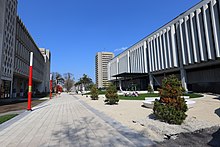
The
The
Three
Quebec City has the oldest educational institution for women in North America, led by the Ursulines of Quebec, which is now a private elementary school.
Sister cities
Quebec City is
It has formal agreements with other cities although they are not active anymore as of 2012. These include
These were the ex Mayor Régis Labeaume's priorities. However, the new mayor Bruno Marchand wants to renew exchanges with the other cities.Notable people
See also
Notes
- ^ The Algonquin language is a distinct language of the Algonquian language family, and is not a misspelling.
- ^ Although snow is measured in cm the melted snow (water equivalent) is measured in mm and added to the rainfall to obtain the total precipitation. An approximation of the water equivalent can be made by dividing the snow depth by ten. Thus 1 cm (0.4 in) of snow is equivalent to approximately 1 mm (0.04 in) of water. See snow gauge, Rainfall, Snowfall, and Precipitation Archived 28 December 2012 at the Wayback Machine and MANOBS 7th Edition Amendment 17[dead link]
- ^ Based on station coordinates provided by Environment and Climate Change Canada, climate data was recorded in the area of Old Quebec from August 1875 to February 1959, and at Québec City Jean Lesage International Airport from March 1943 to present.
- ^ Statistic includes all persons that did not make up part of a visible minority or an indigenous identity.
- ^ Statistic includes total responses of "West Asian" and "Arab" under visible minority section on census.
- ^ Statistic includes total responses of "Filipino" and "Southeast Asian" under visible minority section on census.
- ^ Statistic includes total responses of "Chinese", "Korean", and "Japanese" under visible minority section on census.
- ^ Statistic includes total responses of "Visible minority, n.i.e." and "Multiple visible minorities" under visible minority section on census.
References
- ISBN 2-89464-510-4.
- ^ "Quebec City". Geographical Names Data Base. Natural Resources Canada.
- ^ "Banque de noms de lieux du Québec: Reference number 51718". toponymie.gouv.qc.ca (in French). Commission de toponymie du Québec.
- ^ "Incorporation de Québec". 23 October 2007. Archived from the original on 28 October 2021. Retrieved 11 March 2018.
- ^ a b "Répertoire des municipalités: Geographic code 23027". www.mamh.gouv.qc.ca (in French). Ministère des Affaires municipales et de l'Habitation.
- ^ a b Canada, Government of Canada, Statistics (8 February 2017). "Population and Dwelling Count Highlight Tables, 2016 Census". Archived from the original on 28 October 2021. Retrieved 15 February 2017.
{{cite web}}: CS1 maint: multiple names: authors list (link) - ^ a b Canada, Government of Canada, Statistics (8 February 2017). "Population and Dwelling Count Highlight Tables, 2016 Census". Archived from the original on 23 September 2018. Retrieved 15 February 2017.
{{cite web}}: CS1 maint: multiple names: authors list (link) - ^ Government of Canada, Statistics Canada (February 2021). "Census Profile, 2021 Census – Québec [Population centre]".
- ^ "Quebec City (Code 421) Census Profile". 2011 census. Government of Canada - Statistics Canada.
- ^ Vallières, Marc. "Québec City". Archived from the original on 22 May 2012. Retrieved 17 June 2012.
- ^ "Table 36-10-0468-01 Gross domestic product (GDP) at basic prices, by census metropolitan area (CMA) (x 1,000,000)". Statistics Canada. 27 January 2017. Archived from the original on 22 January 2021. Retrieved 27 April 2021.
- ^ "Quebec". Oxford English Dictionary (Online ed.). Oxford University Press. (Subscription or participating institution membership required.)
- ^ Government of Canada, Natural Resources Canada. "Place names – Québec". www4.rncan.gc.ca. Archived from the original on 28 October 2021. Retrieved 31 March 2019.
- ^ "Québec, Ville [Census subdivision], Quebec and Québec, Territoire équivalent [Census division], Quebec". Census 2016. Statistics Canada. 8 February 2017. Archived from the original on 28 October 2021. Retrieved 3 March 2017.
- ^ Canada, Government of Canada, Statistics (8 February 2017). "Population and Dwelling Count Highlight Tables, 2016 Census". www12.statcan.gc.ca. Archived from the original on 23 September 2018. Retrieved 15 February 2017.
{{cite web}}: CS1 maint: multiple names: authors list (link) - ^ "Historic District of Old Québec Archived 28 June 2011 at the Wayback Machine". World Heritage; UNESCO. Retrieved 12 January 2009.
- ^ "Old Quebec City, Seven Wonders of Canada". cbc.ca. Archived from the original on 7 February 2008. Retrieved 12 February 2008.
- ^ Government of Canada, Public Services and Procurement Canada (28 February 2020). "Québec, City of Québec, Quebec City – Writing Tips Plus – Writing Tools – Resources of the Language Portal of Canada – Canada.ca". Writing Tips Plus. Retrieved 20 May 2022.
- ^ "Québec, City of Québec, Quebec City". Public Works and Government Services Canada. 2016. Archived from the original on 14 September 2016. Retrieved 29 October 2016.
- ^ "Names (geographical)". Public Service Commission of Canada. Archived from the original on 21 November 2016. Retrieved 29 October 2016.
- ^ Government of Canada (8 October 2009). "Geographical Names". The Canadian Style. Archived from the original on 30 October 2016. Retrieved 29 October 2016.
- ^ "Faut-il traduire les toponymes?". Commission de toponymie. 26 November 2020. Retrieved 20 May 2022.
- ^ "Québec en quelques mots". Immigrant Québec (in Canadian French). 22 October 2021. Retrieved 20 May 2022.
- ^ "CBC.CA – Seven Wonders of Canada – Your Nominations – Old Quebec City, Quebec". www.cbc.ca. Archived from the original on 1 April 2019. Retrieved 31 March 2019.
- ^ "Fort Charlesbourg Royal National Historic Site of Canada". www.historicplaces.ca. Parks Canada. Archived from the original on 28 October 2021. Retrieved 6 October 2018.
- ^ "View of Quebec, Capital of Canada". World Digital Library. Archived from the original on 28 October 2021. Retrieved 11 February 2013.
- ISBN 9781351193337. Archivedfrom the original on 28 October 2021. Retrieved 30 June 2019.
- ^ a b c "KIRKE, SIR DAVID, adventurer, trader, colonizer, leader of the expedition that captured Quebec in 1629, and later governor of Newfoundland" Archived 17 September 2020 at the Wayback Machine, Dictionary of Canadian Biography Online
- OCLC 7384608.
- ^ "George R, Proclamation, 7 October 1763 (Royal Proclamation)". PrimaryDocuments.ca. 7 October 1763. Archived from the original on 1 April 2019. Retrieved 31 March 2019.
- doi:10.7202/029642ar. Archivedfrom the original on 29 July 2018. Retrieved 29 July 2018.
- ^ "Ville de Québec – Québec City, Fortress and Port (1756–1867)". Ville de Québec. Archived from the original on 28 October 2021. Retrieved 31 March 2019.
- ^ Clapperton, Nina (18 November 2021). "13 Canada Capital Cities". Nina Out and About. Retrieved 10 April 2022.
- ^ "Canadian Military Heritage Volume 2 (1755–1871). Canadian Militia Unpopular with Francophones". Canadian Military History Gateway. Department of National Defence. June 2017. Archived from the original on 12 October 2018. Retrieved 6 October 2018.
- ^ Richard Preston 'Canada's RMC: A History of the Royal Military College of Canada' published by the RMC Club by U of Toronto Press.
- ^ Geological Survey of Canada (1999). The 1988 Saguenay Earthquake – a Site Visit Report. p. 63.
- ISBN 9780773584860. Archivedfrom the original on 28 October 2021. Retrieved 6 October 2018.
- ^ Décret concernant la révision des limites des régions administratives du Québec, R.Q. c. D-11, r.2, made pursuant to the Territorial Division Act, R.S.Q. c. D-11
- ^ "Québec Portal > Portrait of Québec > Administrative Regions > Regions". Archived from the original on 1 February 2009. Retrieved 13 May 2009.
- ^ "An Act respecting the National capital commission, R.S.Q. c. C-33.1". CanLII. 4 May 2009. Archived from the original on 6 May 2010. Retrieved 13 May 2009.
- (PDF) from the original on 3 February 2012. Retrieved 10 February 2013.
- Environment Canada. 31 October 2011. Archivedfrom the original on 16 August 2016. Retrieved 8 July 2016.
- Environment Canada. 31 October 2011. Archivedfrom the original on 16 August 2016. Retrieved 8 July 2016.
- Environment Canada. 31 October 2011. Archivedfrom the original on 16 August 2016. Retrieved 8 July 2016.
- ^ "Quebec/Jean Lesage INT'L A, Quebec". Canadian Climate Normals 1981–2010. Environment and Climate Change Canada. Archived from the original on 9 May 2014. Retrieved 8 May 2014.
- ^ "QUEBEC/JEAN LESAGE INTL". Canadian Climate Data. Environment and Climate Change Canada. Archived from the original on 17 August 2016. Retrieved 28 March 2016.
- ^ "Quebec". Canadian Climate Data. Environment and Climate Change Canada. Archived from the original on 17 August 2016. Retrieved 28 March 2016.
- ^ Yu Media Group d.o.o. "Quebec city, Canada – Detailed climate information and monthly weather forecast". Weather Atlas. Archived from the original on 6 July 2019. Retrieved 6 July 2019.
- ^ "Nouveau découpage des arrondissements - Modifications territoriales". www.ville.quebec.qc.ca (in French). Ville de Québec. Archived from the original on 25 September 2009.
- ^ Rainville, Candide; Service de l'ingénierie. Division de l'arpentage et de la cartographie. Ville de Québec (10 January 2011). "Les arrondissements et leurs quartiers" [The boroughs and their quarters] (PDF) (Map). clubdimension.org (in French). Archived (PDF) from the original on 5 November 2019. Retrieved 5 November 2019.
- ^ a b "Où sera le centre-ville de Québec dans le futur?". Radio-Canada.ca (in Canadian French). 7 October 2018. Archived from the original on 9 October 2018. Retrieved 9 October 2018.
- ^ 2021census
- ^ "Évolution démographique des 10 principales villes du Québec (Sur la base de 2006) selon leur limites territoriales actuelles1, Recensements du Canada de 1871 à 2006". www.stat.gouv.qc.ca. Archived from the original on 6 October 2013. Retrieved 19 October 2022.
- ^ "Population and dwelling counts: Canada, provinces and territories, and census subdivisions (municipalities), Quebec". Statistics Canada. 9 February 2022. Retrieved 29 August 2022.
- ^ Canada, Government of Canada, Statistics (8 February 2017). "Population and Dwelling Count Highlight Tables, 2016 Census". www12.statcan.gc.ca. Archived from the original on 10 February 2017. Retrieved 9 February 2017.
{{cite web}}: CS1 maint: multiple names: authors list (link) - ^ Government of Canada, Statistics Canada (8 February 2017). "Census Profile, 2016 Census – Québec, Ville [Census subdivision], Quebec and Canada [Country]". www12.statcan.gc.ca. Archived from the original on 28 October 2021. Retrieved 16 July 2019.
- ^ "Census Profile, 2021 - Québec, Ville". Statistics Canada. 9 February 2022.
- ^ "Census Profile, 2021 - Canada [Country]". Statistics Canada. 9 February 2022.
- ^ a b c d Government of Canada, Statistics Canada (26 October 2022). "Census Profile, 2021 Census of Population". www12.statcan.gc.ca. Retrieved 9 November 2022.
- ^ Government of Canada, Statistics Canada (27 October 2021). "Census Profile, 2016 Census". www12.statcan.gc.ca. Retrieved 12 January 2023.
- ^ Government of Canada, Statistics Canada (27 November 2015). "NHS Profile". www12.statcan.gc.ca. Retrieved 12 January 2023.
- ^ Government of Canada, Statistics Canada (20 August 2019). "2006 Community Profiles". www12.statcan.gc.ca. Retrieved 12 January 2023.
- ^ Government of Canada, Statistics Canada (2 July 2019). "2001 Community Profiles". www12.statcan.gc.ca. Retrieved 12 January 2023.
- ^ Morrin Centre. "Anglos in Québec". Literary and Historical Society of Quebec. Archived from the original on 6 March 2012. Retrieved 15 March 2007.
- ^ Blair, Louisa. The Anglos: The Hidden Face of Quebec City. Volume 1: 1608–1850; Volume 2: Since 1850. Québec: Commission de la capitale nationale du Québec & Éditions Sylvain Harvey, 2005.
- ^ "Voice of English-speaking Québec: A Portrait of the English-speaking Community in Quebec". Voice of English-speaking Québec. 2007. Archived from the original on 29 September 2007. Retrieved 15 March 2007.
- ^ "Canada's largest employers by city, 2007: Quebec City". University of Western Ontario. Archived from the original on 18 April 2010.
- ^ "Here's a quick glance at unemployment rates for June, by Canadian city". Financial Post. 6 July 2018. Archived from the original on 9 October 2018. Retrieved 9 October 2018.
- ^ "Québec City: Economy, transportation, and labour force" Archived 25 September 2017 at the Wayback Machine. The Canadian Encyclopedia. Historical Foundation of Canada, 2008. Retrieved 12 January 2009.
- ^ "Abandoned zoo greenhouse faces demolition". QCNA EN. 23 November 2021. Retrieved 28 September 2022.
- ^ "2022 - The greenhouse of the former Quebec zoo will indeed be demolished, confirms the City - Actual News Magazine" (in Turkish). 9 December 2021. Retrieved 28 September 2022.
- ^ Marsh, James A. (30 October 2014), "Quebec City in the War of 1812", The Canadian Encyclopedia, Historica Canada, retrieved 26 March 2023
- ISBN 978-0-7735-0310-6.
- OCLC 31779784.
- ^ The 37 sites in Quebec City are listed in the Directory of Federal Heritage Designations as being located in Québec and the following boroughs/enclaves: Beauport, Cap-Rouge, Notre-Dame-des-Anges, Sainte-Foy and Wendake.
- ^ "Ville de Québec – Parks and Gardens". www.ville.quebec.qc.ca. Archived from the original on 14 November 2016. Retrieved 14 November 2016.
- ^ "Le Parc Chauveau: la nature à ma portée!" (PDF) (in French). Ville de Québec. Archived (PDF) from the original on 4 March 2016. Retrieved 6 October 2018.
- ^ Hogdson, Larry (8 September 2018). "Québec, toujours un désert botanique?". Le Soleil (in Canadian French). Archived from the original on 6 October 2018. Retrieved 6 October 2018.
- ^ Québec, Office du tourisme de. "Promenade Samuel-De Champlain". Official Web Site – Québec City Tourism. Archived from the original on 6 October 2018. Retrieved 6 October 2018.
- ^ "History of Major Special Olympics Canada (SOC) Events" (PDF). Special Olympics Canada. 29 January 2007. Archived from the original (PDF) on 6 July 2011. Retrieved 14 July 2011.
- ^ "Here comes the 4th Tour de Québec!". tourdequebec.com. Archived from the original on 9 March 2012. Retrieved 14 July 2011.
- ^ Karine Gagnon, Qmi Agency (1 March 2011). "Quebecor joins arena plan, eyes NHL team | Hockey | Sports". Toronto Sun. Archived from the original on 1 October 2012. Retrieved 2 January 2012.
- ^ McParland, Kelly (2 March 2011). "The Quebec gravy train chugs off without Ottawa on board for once". National Post. Archived from the original on 11 March 2011.
- ^ "Quebec City plans $400 million arena to attract NHL team, Winter Olympics — ESPN". Sports.espn.go.com. 16 October 2009. Archived from the original on 29 June 2011. Retrieved 2 January 2012.
- ^ "Quebec city FIS Cross-Country World Cup 2019". Quebec City FIS Cross-Country World Cup. Archived from the original on 6 August 2020. Retrieved 30 March 2020.
- ^ a b Duval, Alexandre (11 August 2017). "Politique : un chercheur perce une partie du " mystère Québec "". Radio-Canada.ca (in Canadian French). Archived from the original on 9 October 2018. Retrieved 8 October 2018.
- ^ Daoust, Jean-François (15 August 2017). "Le mystère de Québec: les moins bien nantis rejettent la gauche". Le Devoir (in French). Archived from the original on 9 October 2018. Retrieved 8 October 2018.
- ^ Himelfarb, Jordan (10 October 2018). "The Bloc's Quebec City fortress". The Globe and Mail. Archived from the original on 28 October 2021. Retrieved 8 October 2018.
- ^ Peritz, Ingrid (31 August 2012). "Seeking clues to Quebec City's ballot box mystery". The Globe and Mail. Archived from the original on 1 September 2012. Retrieved 8 October 2018.
- ^ Castonguay, Alec (31 August 2012). "Le faux mystère de Québec". L’actualité (in Canadian French). Archived from the original on 10 October 2018. Retrieved 8 October 2018.
- ^ Bilefsky, Dan (18 August 2018). "Quebec's 'Trash Radio' Host Fires Up Outrage, and Big Ratings". The New York Times. Archived from the original on 9 October 2018. Retrieved 8 October 2018.
- ^ Lachance, Nicolas (20 December 2015). "Il perce (enfin) le mystère Québec". Le Journal de Québec (in Canadian French). Archived from the original on 10 October 2018. Retrieved 8 October 2018.
- ^ Séguin, Rheal (2 May 2011). "Quebec City gives NDP control over the region". The Globe and Mail. Archived from the original on 28 October 2021. Retrieved 8 October 2018.
- ^ "Official Voting Results Raw Data (poll by poll results in Quebec City)". Elections Canada. 7 April 2022. Retrieved 28 February 2023.
- ^ "Official Voting Results by polling station (poll by poll results in Quebec City)". Elections Québec. Retrieved 28 February 2023.
- ^ "Conseils d'arrondissement". Ville de Québec. Archived from the original on 6 October 2014.
- ^ "Conseils de quartier". Ville de Québec. Archived from the original on 8 March 2017.
- ^ "2017 Police-reported Crime Severity Index and crime rate, by census metropolitan area". Statistics Canada. 23 July 2018. Archived from the original on 21 October 2018. Retrieved 9 October 2018.
- ^ White, Marianne (28 December 2007). "Quebec City closing in on a year without murder". Nationalpost.com. Retrieved 14 July 2011.
- ^ Neron, Jean-François (2010). "Bas taux d'homicide: fiche impressionnante pour Québec" (in French). Le Soleil. Archived from the original on 29 July 2018. Retrieved 29 July 2018.
- ^ "Suspect in Quebec mosque terror attack was of Moroccan origin, reports show". Fox News. 30 January 2017. Archived from the original on 30 January 2017. Retrieved 30 January 2017.
- ^ "Police-reported crime statistics in Canada, 2017". Statistics Canada. 23 July 2018. Archived from the original on 21 October 2018. Retrieved 9 October 2018.
- ^ "Hate crimes targeting Muslims doubled in 2017, says Quebec City police chief". CBC News. Archived from the original on 21 October 2018. Retrieved 3 September 2018.
- ^ "Reported hate crimes jumped in Quebec City in year prior to mosque shooting". CBC News. 29 November 2018. Archived from the original on 16 December 2018. Retrieved 3 September 2018.
- ^ "Rapport annuel 2018" (PDF). Service de Police de la Ville de Québec (in French). p. 14. Archived (PDF) from the original on 28 October 2021. Retrieved 22 June 2019.
- ^ "Rapport annuel 2017" (PDF). Service de Police de la Ville de Québec (in French). p. 12. Archived (PDF) from the original on 21 December 2018. Retrieved 8 December 2018.
- ^ "Rapport annuel 2016" (PDF). Service de Police de la Ville de Québec (in French). p. 20. Archived (PDF) from the original on 13 February 2018. Retrieved 8 December 2018.
- ^ Bilefsky, Dan (November 2020). "Halloween Stabbing Attack in Quebec City Leaves 2 Dead". The New York Times. Archived from the original on 4 January 2021. Retrieved 1 November 2020.
- ^ "Projet de prolongement de l'axe du Vallon" (PDF). BAPE (in French). 2004. p. 2. Archived from the original (PDF) on 29 March 2018. Retrieved 21 March 2017.
- ^ "Quebec City tramway finally gets green light as province gives unconditional approval". CBC. 6 April 2022.
- ^ "We represent the interests of rail and bus passengers and advocate for public transport services in Canada". 28 April 2021.
- ^ "Quebec city Tram Will Be A Reality : Rail for the Valley". 6 April 2022.
- ^ "Port of Quebec". Archived from the original on 3 February 2012. Retrieved 24 June 2009.
- ^ "Québec fait le ménage dans ses jumelages". Le Soleil (in French). 7 September 2012. Archived from the original on 21 September 2016.
External links
- Official website

- Official website of Québec City Tourism
- Focus on Geography Series, 2016 Census — Census subdivision of Québec City from Statistics Canada
- CBC Digital Archives — CBC Television Special: Preserving Quebec City (1976)
- CBC Digital Archives — Quebec City: 400 Years of History


